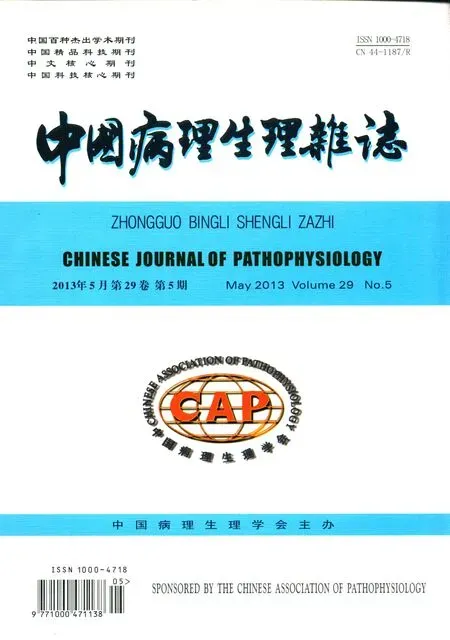Caveolae-caveolin-1-PTRF/cavin-1系统与血管平滑肌细胞迁移:一种可能的机制*
陈兆煜, 袁 乔, 谈 智
(中山大学 1中山医学院临床医学系, 2光华口腔医学院口腔医学系, 3中山医学院生理教研室,广东 广州 510080)
Caveolae-caveolin-1-PTRF/cavin-1系统与血管平滑肌细胞迁移:一种可能的机制*
陈兆煜1, 袁 乔2, 谈 智3△
(中山大学1中山医学院临床医学系,2光华口腔医学院口腔医学系,3中山医学院生理教研室,广东 广州 510080)
动脉粥样硬化性疾病(如冠状动脉粥样硬化和脑动脉粥样硬化)仍是全球范围内引起死亡的主要原因[1]。在动脉粥样硬化的演变过程中,血管壁首先表现为动脉内膜的增厚,内膜增厚可以由于年龄和应对逐渐升高的血压导致内膜损伤而产生[2]。在内膜损伤后,多种细胞包括内皮细胞、血小板和炎症细胞释放多种介质(如生长因子和细胞因子)能够激活血管平滑肌细胞(vascular smooth muscle cells, VSMCs)和单核-巨噬细胞,引起VSMCs从血管肌层迁移到内膜层并且在内膜层增殖和产生大量基质和吸引单核巨噬细胞趋化、迁移至内膜层[3-4]。内膜增厚与内膜层中VSMCs数目的增多和VSMCs相关的细胞外基质的增加有关[2]。迁移到内膜的VSMCs和巨噬细胞吞噬经破损内膜进入的脂质,分别成为VSMCs来源的泡沫细胞和巨噬细胞来源的泡沫细胞,从而使脂质积聚于血管[4]。VSMCs脂质聚积会导致其表面纤维蛋白和I型胶原下降[5],这是引起动脉粥样硬化斑块破裂,从而导致猝死的主要原因[6]。平滑肌细胞从血管肌层迁移到内膜层是动脉粥样硬化演变过程中的主要因素[7],因此认识这一迁移过程的机制显得尤为重要。
1 微囊(caveolae)与VSMCs迁移
细胞迁移过程中涉及多种细胞结构及细胞结构蛋白[8],微囊也称作小凹或陷窝是一类50~100 nm大小的细胞膜上呈长颈瓶样(flask-shaped)内陷入胞浆的细胞膜亚单位结构[9-10],存在于多种细胞的细胞膜上,但大量分布于内皮细胞、心肌细胞、平滑肌细胞、上皮细胞、I型肺泡细胞等细胞的细胞膜。微囊结构中富含糖基磷脂酰肌醇(glycosyl phosphatidylinositol, GPI)锚定蛋白、胆固醇和鞘糖脂,这种特殊的脂质结构在洗涤剂中难溶解,因而可以根据这个特性来提纯微囊结构[11]。研究发现微囊中存在大量与细胞迁移以及增殖相关的酶和受体如Src样激酶、表皮生长因子受体(epidermal growth factor receptor,EGFR)和血小板源性生长因子受体(platelet-derived growth factor receptor,PDGFR),调控细胞内钙离子稳态的分子如胞膜钙泵和三磷酸肌醇(inositol 1,4,5-triphosphate, IP3)受体,以及G蛋白相关的信号分子如G蛋白偶联受体和腺苷酸环化酶[10-11]。
2 小凹蛋白1(caveolin-1,Cav-1)与VSMCs迁移
在脊椎动物中,微囊有3种跨膜结构蛋白,分别是Cav-1、Cav-2和Cav-3。Caveolins主要存在于细胞膜上,也有小部分存在于高尔基复合体、内质网、囊泡和胞浆中。这3种caveolins含量最高的是Cav-1(又称VIP21),主要分布于终末分化细胞如脂肪细胞、内皮细胞、平滑肌细胞和I型肺泡细胞。Cav-2主要与Cav-1共表达,需要Cav-1提供靶位点才能结合在胞膜上。Cav-3的氨基酸序列与Cav-1较为相似,有组织特异性,主要表达在平滑肌细胞、骨骼肌细胞和心肌细胞[12]。
Cav-1是微囊形呈的重要的结构,其表达与微囊的形成呈直接的平行关系,而当微囊在细胞转化过程中消失时,Cav-1的mRNA以及蛋白的表达停止或者减少。在敲除Cav-1的细胞株上,通过转染富含Cav-1的质粒使得上述细胞株的细胞膜上的微囊重新形成,并且微囊在细胞膜上所占的面积比例大大提高,但何种因素调控Cav-1聚集形成微囊仍未明确[11]。
已有研究提出Cav-1通过调控信号分子的极化在细胞的迁移中起重要的作用[9,13-14]。Cav-1和层黏连蛋白(lamin)与细胞骨架成分β-actin或γ-actin相连,同时也通过细丝蛋白(filamin)与整合素相联系[15]。Caveolae和Cav-1在内皮细胞迁移过程中显示极化分布现象[16-17]。然而关于Cav-1在细胞的迁移中的调控作用存在着争议,有研究表明Cav-1表达量的增加能够抑制细胞迁移[18]。Cav-1缺陷细胞正常的极化现象和定向迁移能力消失,RhoA的表达下降而Rac和Cdc42的表达上升抑制细胞迁移所需要的结构如黏着斑(focal adhesions, FAs)、丝状伪足等成熟,从而抑制细胞的迁移[14]。RhoA、Rac1和Cdc42是Rho GTP激酶家族的3个重要成员,能够调控细胞骨架的重构FAs的形成和重新分布,肌动蛋白的聚集,丝状伪足、板状伪足、细胞膜皱褶和调节应力纤维的形成以及细胞的收缩性,从而实现对细胞迁移的调控[8,19],阻断Rho GTP激酶的表达,则VSMCs迁移的表型改变消失[20],提示Cav-1通过调节Rho GTP酶来调控细胞的迁移。EGFR和PDGFR与Cav-1共分布于微囊中,Cav-1分别通过与EGFR和PDGFR结合,抑制EGFR和PDGFR的自我磷酸化,从而抑制EGFR和PDGFR的功能[21],而EGFR信号通路和PDGFR信号通路与细胞的迁移和增殖密切相关,也提示了Cav-1对细胞的迁移起负性调控作用。与此相反,有研究表明Cav-1是负调控因子,恢复MTLn3细胞的Cav-1的表达,可以减少MTLn3细胞板状伪足的形成和趋化性迁移[22],敲除Cav-1基因能增加内皮细胞的定向迁移[23]。因此Cav-1在调控细胞迁移的作用机制仍不明确。
3 聚合酶I和转录释放因子(polymerase I and transcript release factor, PTRF)与细胞迁移
PTRF又称cavin-1,在过去被认为是RNA核酸聚合酶I(RNA polymerase I,Pol I)转录终止作用的关键分子,甲状腺转录因子I(thyroid transcription factor I, TTF-I)和PTRF/cavin-1是Pol I转录终止2个关键步骤的重要分子。TTF-I通过结合于rDNA下游的一个叫作“Sal box”的终止子使Pol I复合体的延伸作用中止,接着PTRF/cavin-1与Pol I 复合体中前体rRNA的3’末端结合,同时也与Pol I和TTF-I相互作用,从而使Pol I从模板中释放出来[24-25]。随后的研究发现,PTRF/cavin-1在微囊中大量存在,并且与Cav-1共分布于微囊中(位于微囊的胞浆侧)和细胞骨架蛋白有着密切的联系[26-27]。过度表达PTRF/cavin-1或者下调PTRF/cavin-1的表达能引起Cav-1表达量相应的改变,同时发现过度表达PTRF/cavin-1,细胞能形成明显的细胞骨架样的结构,当使微管或者肌动蛋白丝解聚能减少PTRF/cavin-1结合于细胞膜的脂质层,而对Cav-1没有显著的影响[27]。敲除PTRF/cavin-1能减少胞膜中微囊的密度,而Cav-1仍存在于细胞膜中,但不能聚集形成微囊,重新导入PTRF/cavin-1,发现微囊结构的形成[28]。在PTRF/cavin-1基因敲除的小鼠组织细胞中,微囊结构消失[29]。这些结果提示PTRF/cavin-1通过与细胞骨架分子相互作用在微囊的形成中起重要的作用。
在前列腺癌PC3细胞中,PTRF/cavin-1的稳定表达可以抑制PC3细胞的迁移以及减少基质金属蛋白酶9(matrix metalloproteinase 9,MMP-9)的生成[30],而在另一种不表达PTRF/cavin-1的前列腺癌细胞株LnCAP中富含MMP-9,MMP-9能够降解细胞外基质成分中的IV、V、VII、X和XIV型胶原以及纤连蛋白、层黏连蛋白、巢蛋白、蛋白聚糖连接蛋白、多功能蛋白聚糖[30-31]。 PTRF/cavin-1抑制PC3细胞的迁移和减少细胞外基质的降解也与Cav-1的表达增加有关,因此抑制PC3细胞的迁移和减少细胞外基质的降解与微囊和Cav-1也有关[30]。 在细丝环损伤小鼠动脉后,与对照组相比,敲除MMP-9基因的小鼠VSMCs迁移能力下降,内膜增厚不明显[32],这提示PTRF/cavin-1在VSMCs的迁移也存在与PC3细胞迁移的类似机制,但未见相关的报道。
4 结语
综上所述,VSMCs迁移在动脉粥样硬化的发生、发展和演变的过程中起着重要的作用,而微囊在VSMCs的迁移中起着重要的作用,其结构蛋白Cav-1在介导VSMCs迁移中的作用存在着争议,目前无法明确这种争议的原因。新近研究表明,细胞质膜微囊结构蛋白PTRF/cavin-1在细胞的迁移中起重要的作用,提示PTRF/cavin-1可能在Cav-1和caveolae的上游介导细胞的迁移。PTRF/cavin-1很有可能在介导VSMCs的迁移中起着重要作用,因此研究PTRF/cavin-1在介导VSMCs迁移的作用有可能可以阐明动脉粥样硬化发病的机制。
[1] Tabas I. Macrophage death and defective inflammation resolution in atherosclerosis[J]. Nat Rev Immunol,2010,10(1):36-46.
[2] Newby AC. Matrix metalloproteinases regulate migration, proliferation, and death of vascular smooth muscle cells by degrading matrix and non-matrix substrates[J]. Cardiovasc Res,2006,69(3):614-624.
[3] Rudijanto A. The role of vascular smooth muscle cells on the pathogenesis of atherosclerosis[J].Acta Med Indones, 2007,39(2):86-93.
[4] Koga J, Aikawa M. Crosstalk between macrophages and smooth muscle cells in atherosclerotic vascular diseases[J]. Vasc Pharmacol,2012,57(1):24-28.
[5] Frontini MJ, O’Neil C, Sawyez C, et al. Lipid incorporation inhibits Src-dependent assembly of fibronectin and type I collagen by vascular smooth muscle cells[J]. Circ Res, 2009, 104(7):832-841.
[6] 郑广娟,朱 莹,王 婷. 虎杖配伍山楂抗动脉粥样硬化易损斑块病变的机制研究[J]. 中国病理生理杂志,2010,26(4):635-639.
[7] Willis AI, Pierre-Paul D, Sumpio BE, et al. Vascular smooth muscle cell migration: current research and clinical implications[J]. Vasc Endovasc Surg,2004,38(1):11-23.
[8] Grande-García A, Echarri A, de Rooij J, et al. Caveolin-1 regulates cell polarization and directional migration through Src kinase and Rho GTPases[J]. J Cell Biol,2007,177(4):683-694.
[9] Parton RG, Hanzal-Bayer M, Hancock JF. Biogenesis of caveolae: a structural model for caveolin-induced domain formation[J]. J Cell Sci,2006,119(Pt 5):787-796.
[10] Lisanti MP, Scherer PE, Vidugiriene J, et al. Characterization of caveolin-rich membrane domains isolated from an endothelial-rich source: implications for human disease[J]. J Cell Biol,1994,126(1):111-126.
[11] Schlegel A, Volonte D, Engelman JA, et al. Crowded little caves: structure and function of caveolae[J]. Cell Signal,1998,10(7):457-463.
[12] Williams TM, Lisanti MP. The caveolin proteins[J].Genome Biol, 2004,5(3):214.
[13] Isshiki M, Ando J, Yamamoto K, et al. Sites of Ca2+wave initiation move with caveolae to the trailing edge of migrating cells[J]. J Cell Sci,2002,115(Pt 3):475-484.
[14] Grande-García A, Del PM. Caveolin-1 in cell polarization and directional migration[J]. Eur J Cell Biol,2008,87(8-9):641-647.
[15] Halayko AJ, Stelmack GL. The association of caveolae, actin, and the dystrophin-glycoprotein complex: a role in smooth muscle phenotype and function?[J]. Can J Physiol Pharmacol,2005,83(10):877-891.
[16] Parat MO, Anand-Apte B, Fox PL. Differential caveolin-1 polarization in endothelial cells during migration in two and three dimensions[J]. Mol Biol Cell,2003,14(8):3156-3168.
[17] Beardsley A, Fang K, Mertz H, et al. Loss of caveolin-1 polarity impedes endothelial cell polarization and directional movement[J]. J Biol Chem,2005,280(5):3541-3547.
[18] Takaguri A, Shirai H, Kimura K, et al. Caveolin-1 negatively regulates a metalloprotease-dependent epidermal growth factor receptor transactivation by angiotensin II[J]. J Mol Cell Cardiol,2011,50(3):545-551.
[19] Vicente-Manzanares M, Webb DJ, Horwitz AR. Cell migration at a glance[J]. J Cell Sci, 2005,118(21):4917-4919.
[20] Fukata M, Nakagawa M, Kaibuchi K. Roles of Rho-family GTPases in cell polarisation and directional migration[J]. Curr Opin Cell Biol,2003,15(5):590-597.
[21] Park WY, Cho KA, Park JS, et al. Attenuation of EGF signaling in senescent cells by caveolin[J]. Ann N Y Acad Sci,2001,928:79-84.
[22] Zhang W, Razani B, Altschuler Y, et al. Caveolin-1 inhibits epidermal growth factor-stimulated lamellipod extension and cell migration in metastatic mammary adenocarcinoma cells (MTLn3). Transformation suppressor effects of adenovirus-mediated gene delivery of caveolin-1[J]. J Biol Chem,2000,275(27):20717-20725.
[23] Gonzalez E, Nagiel A, Lin AJ, et al. Small interfering RNA-mediated down-regulation of caveolin-1 differentially modulates signaling pathways in endothelial cells[J]. J Biol Chem,2004,279(39):40659-40669.
[24] Mason SW, Sander EE, Grummt I. Identification of a transcript release activity acting on ternary transcription complexes containing murine RNA polymerase I[J]. EMBO J,1997,16(1):163-172.
[25] Jansa P, Mason SW, Hoffmann-Rohrer U, et al. Cloning and functional characterization of PTRF, a novel protein which induces dissociation of paused ternary transcription complexes[J]. EMBO J,1998,17(10):2855-2864.
[26] Pilch PF, Souto RP, Liu L, et al. Cellular spelunking: exploring adipocyte caveolae[J]. J Lipid Res,2007,48(10):2103-2111.
[27] Liu L, Pilch PF. A critical role of cavin (polymerase I and transcript release factor) in caveolae formation and organization[J]. J Biol Chem,2008,283(7):4314-4322.
[28] Hill MM, Bastiani M, Luetterforst R, et al. PTRF-Cavin, a conserved cytoplasmic protein required for caveola formation and function[J]. Cell,2008,132(1):113-124.
[29] Liu L, Brown D, Mckee M, et al. Deletion of Cavin/PTRF causes global loss of caveolae, dyslipidemia, and glucose intolerance[J]. Cell Metab,2008,8(4):310-317.
[30] Aung CS, Hill MM, Bastiani M, et al. PTRF-cavin-1 expression decreases the migration of PC3 prostate cancer cells: role of matrix metalloprotease 9[J]. Eur J Cell Biol, 2011, 90(2-3): 136- 142.
[31] Gueron G, De Siervi A, Ferrando M, et al. Critical role of endogenous heme oxygenase 1 as a tuner of the invasive potential of prostate cancer cells[J]. Mol Cancer Res,2009,7(11):1745-1755.
[32] Galis ZS, Johnson C, Godin D, et al. Targeted disruption of the matrix metalloproteinase-9 gene impairs smooth muscle cell migration and geometrical arterial remodeling[J]. Circ Res, 2002,91(9):852-859.
Caveolae-caveolin-1-PTRF/cavin-1systemandVSMCmigration:apossiblemechanism
CHEN Zhao-yu1, YUAN Qiao2, TAN Zhi3
(1DepartmentofClinicalMedicine,ZhongshanSchoolofMedicine,2DepartmentofStomatologicalMedicine,GuanghuaSchoolofStomatology,3DepartmentofPhysiology,ZhongshanSchoolofMedicine,SunYat-senUniversity,Guangzhou510080,China.E-mail:tanzhi@mail.sysu.edu.cn)
The migration of vascular smooth muscle cells (VSMCs) from the media to the intima of artery plays an important role in the genesis and development of atherosclerosis. Caveolaes, the 50~100 nm membrane microdomains and flask-shaped organelles, contain several ingredients involved in the cell migration. Caveolin-1 (Cav-1), a 22-kD integral membrane protein and an important structural component of caveolae, mediates the migration of VSMCs. Polymerase I and transcript release factor (PTRF/cavin-1) co-localize with Cav-1 in caveolaes and directly interact with cytoskeleton network. PTRF/cavin-1 decreases the migration of prostate cancer PC3 cells, but without similar reports in VSMCs. Therefore, Caveolae-caveolin-1-PTRF/cavin-1 system might act as another mechanism of migration of VSMCs in the development of atherosclerosis.
动脉粥样硬化; 血管平滑肌细胞; 细胞迁移; 微囊; 小凹蛋白1; 聚合酶I和转录释放因子
Atherosclerosis; Vascular smooth muscle cells; Cell migration; Caveolae; Caveolin-1; Polymerase I and transcript release factor
R363
A
10.3969/j.issn.1000- 4718.2013.05.034
1000- 4718(2013)05- 0957- 04
2012- 12- 11
2013- 03- 27
国家自然科学基金资助项目(No. 81270377);中山大学实验室开放基金资助项目(No.KF201245)
△通讯作者 Tel: 020-87332091; E-mail: tanzhi@mail.sysu.edu.cn

